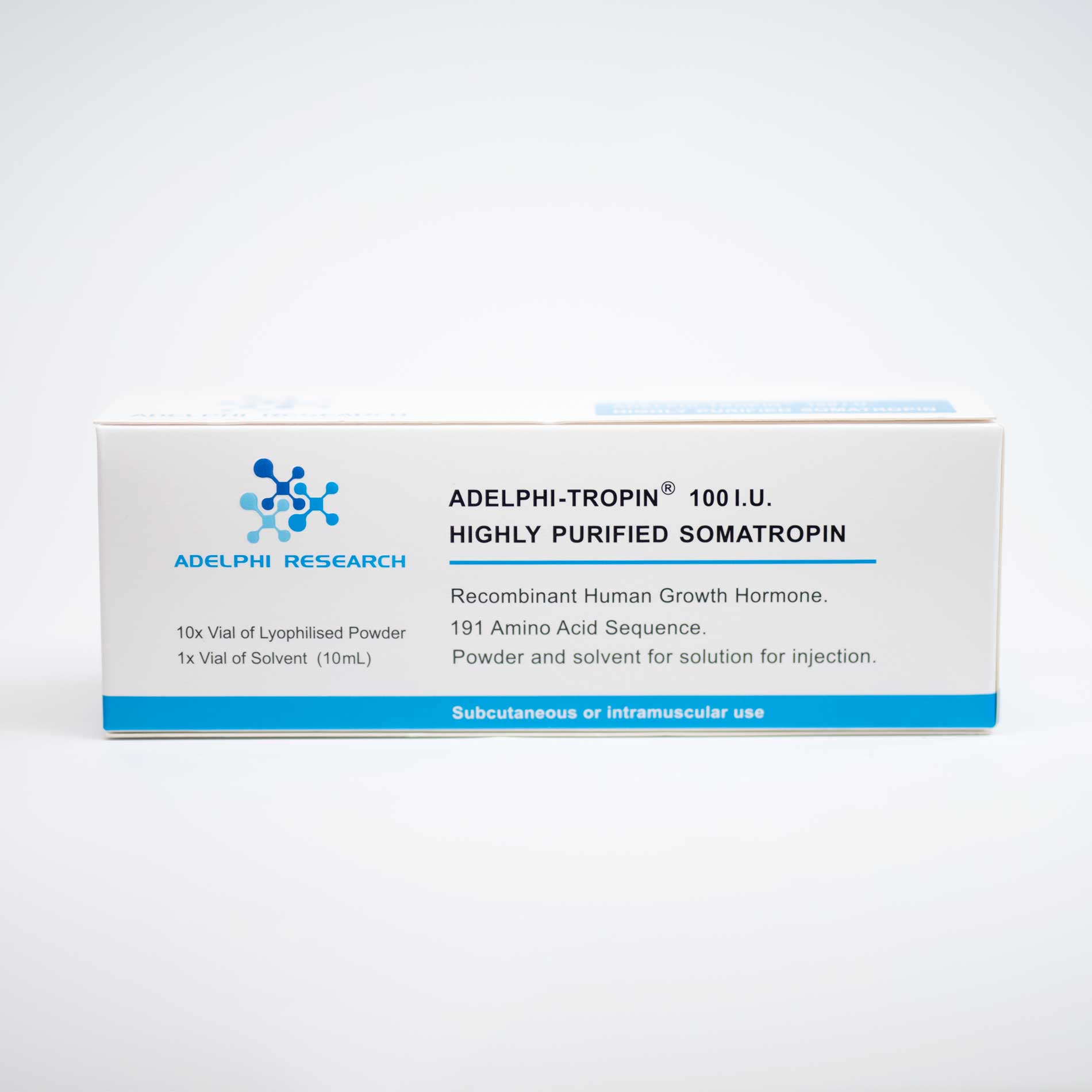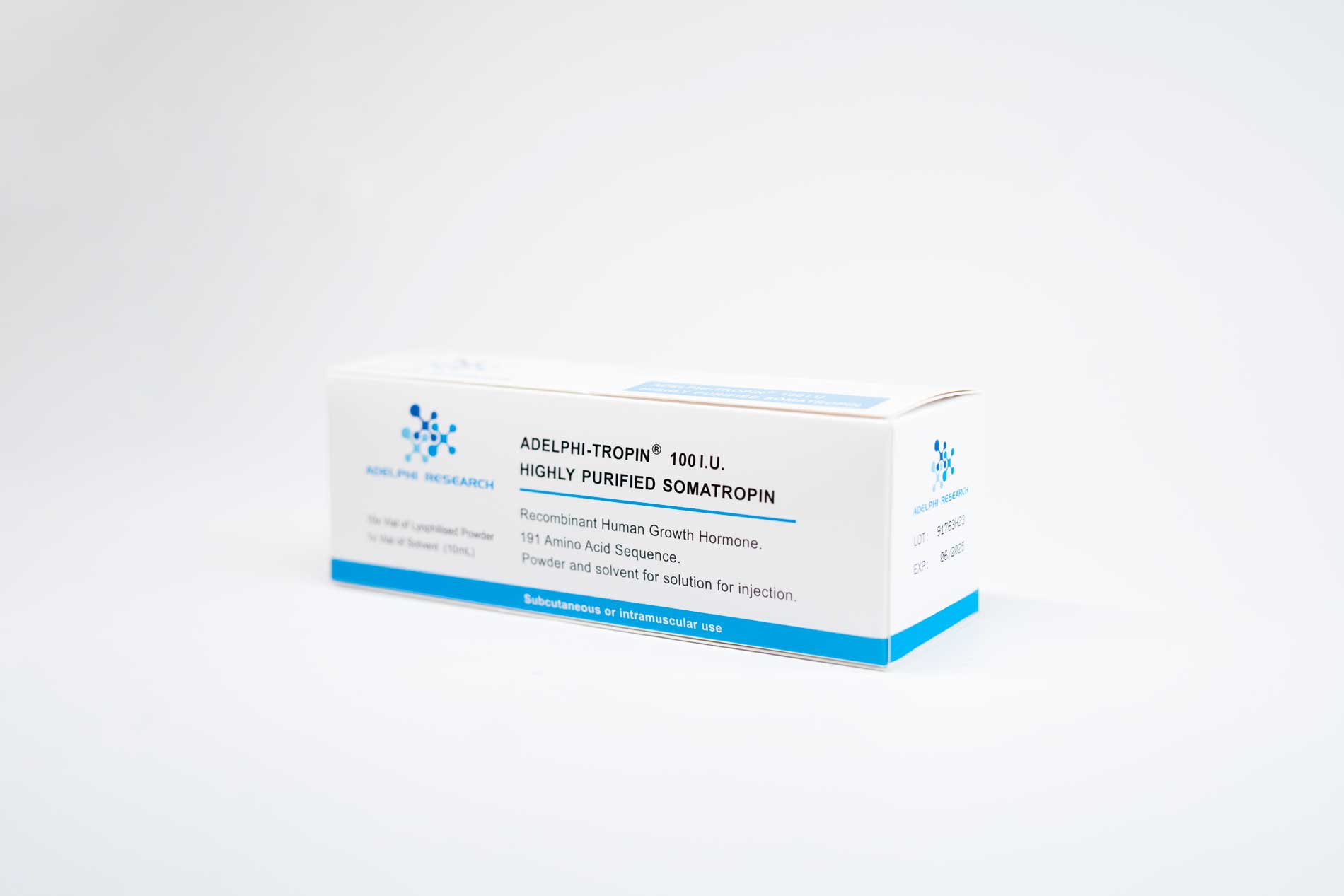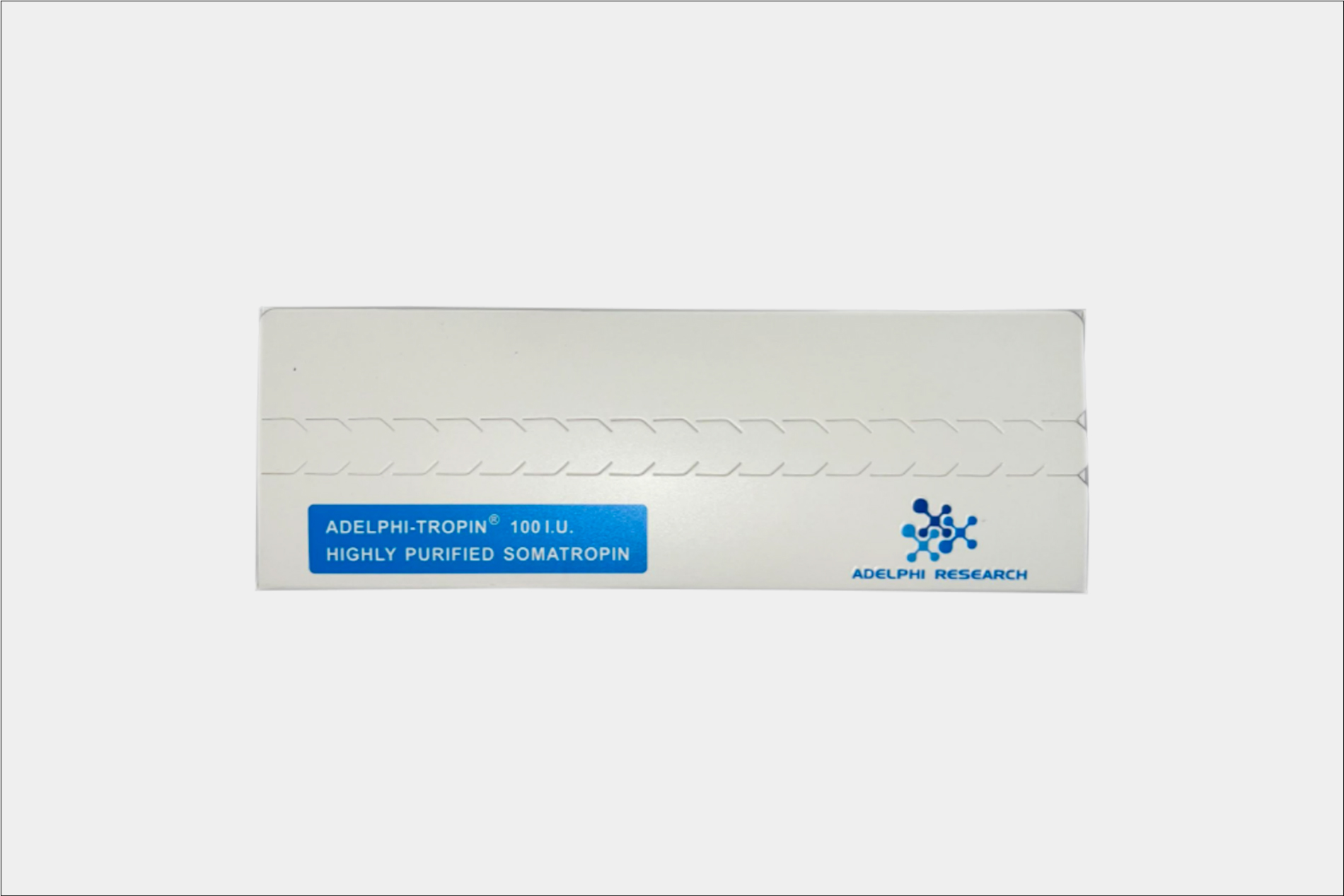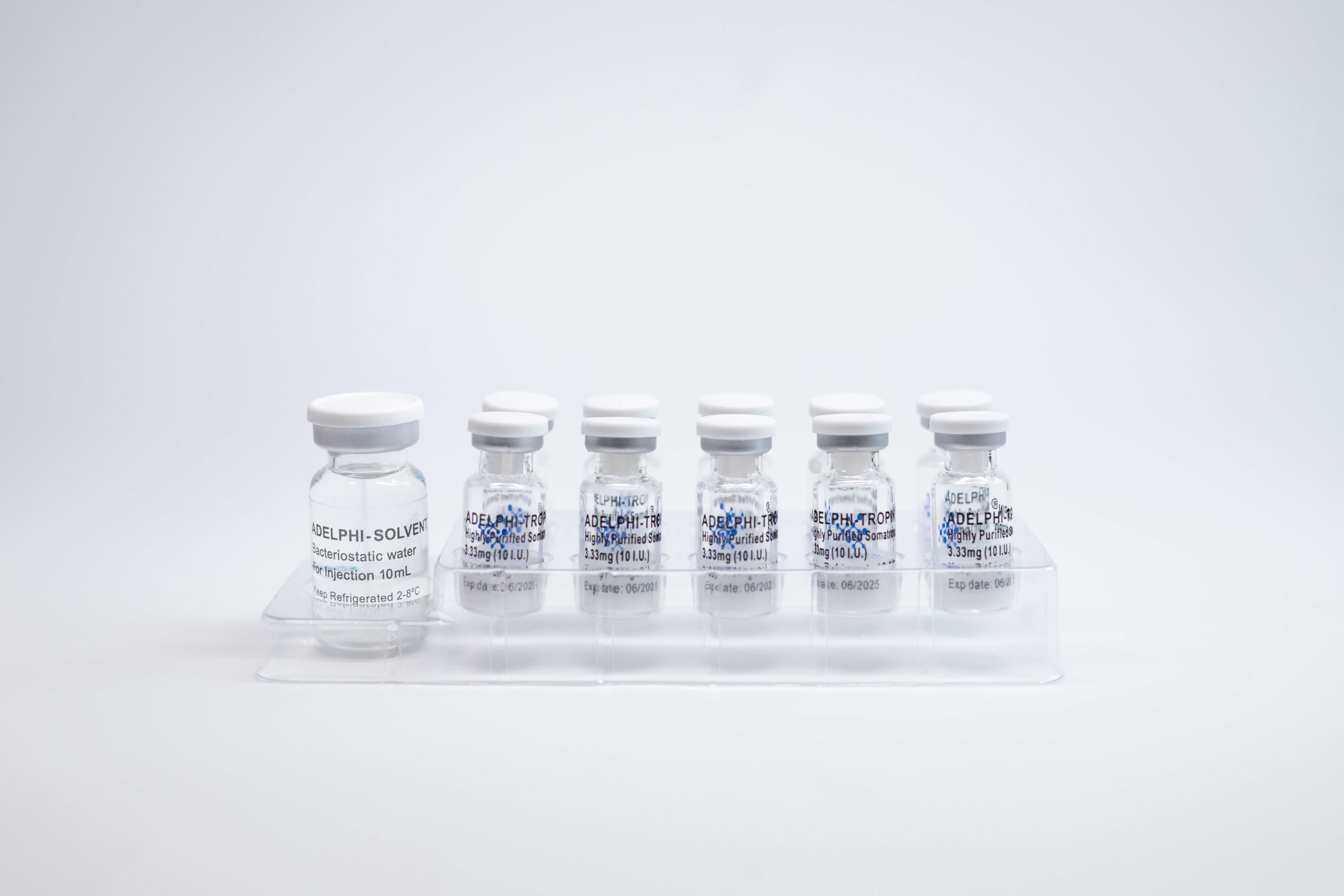Highly purified Somatropin
Recombinant human growth hormone (HGH)
191 amino acid sequenceEffects of Human Growth Hormone:
- Enhanced Ability to Maintain Proper Body Fat Levels
- Decreased Body Fat
- A Tighter Physique
- Enhanced Metabolic Rate
- Enhanced Sense of Wellbeing
- Healthier Skin
- Improved Sleeping Patterns
- Increased Bone Strength
- Increased Energy
- Increased Joint Strength
- Increased Lean Tissue Growth
- Increased Rate of Physical Recovery
- Increased Tendon Strength
Powder and solvent for solution for injection;
10x Vial of lyophilised powder
1x Vial of solvent (10mL)

Description
Human Growth Hormone (HGH) is not only one of the most beneficial hormones our body produces, but one of the most sought after in exogenous form. In an exogenous form, HGH is identical to the naturally produced hormone, and represents not only one of the most beneficial exogenous hormones but one of the most well-tolerated among men and women. Its high level of toleration applies not only to medicinal use but performance enhancement as well.
Commonly, those in the media or in any popular culture conversation refer to Human Growth Hormone as an anabolic steroid. However, HGH is in no shape or form an anabolic steroid. Yes, it does carry strong anabolic properties, but being anabolic does not make something an anabolic steroid. Food is also highly anabolic, but no one would call chicken or ground beef an anabolic steroid.
The use of Human Growth Hormone was first successful in 1958. At this time, HGH was a pituitary extract; it was directly extracted from the pituitary of human cadavers. In 1985, the U.S. FDA would ban its use. Extracted HGH had been successful in many treatment plans, but it also proved to carry with it strong unsanitary disadvantages. In fact, pituitary HGH was linked to CJD, a degenerative brain disorder that is fatal. However, very few fell prey to CDJ, approximately 1% of all users, but this was enough for the FDA to impose a ban.
With the FDA banning HGH extract, soon after somatrem would be released. This was not a pure HGH match but rather a contaminant free variant of the hormone. Shortly after, Kabi Vitrum of Sweden would bring forth the means of synthesizing pure Human Growth Hormone. This would be a pure synthetic and contaminant form of HGH known as Somatropin. This process was made possible thanks to recombinant DNA technology, and since that time all synthetic HGH, regardless of the brand, is officially known as Somatropin. When it comes to the effectiveness and traits associated with Human Growth Hormone, synthetic or naturally derived there is no difference.
Human Growth Hormone Functions & Traits:
Human Growth Hormone is a protein hormone produced by the anterior pituitary gland. It is produced by all living human beings, and is at its highest levels during childhood. HGH represents one of the most important hormones in the human body as it affects our bones, skeletal muscle and internal organs, as well as plays roles in numerous other areas throughout the body.
Human Growth Hormone also supports the metabolism of carbohydrates, fats and minerals. Through its direct mode of action, it can also stimulate the growth of connective tissue. Beyond connective tissue growth, HGH has been shown to significantly increase the size and number of cells in skeletal muscle. The hormone will also further support triglyceride hydrolysis, which in turn will promote the reduction of adipose tissue or body fat. So effective in its abilities surrounding fat, HGH has been shown to significantly reduce total cholesterol levels. This, among many other things can be very useful to the anabolic steroid user as many steroids tend to support improper cholesterol levels.
In its direct functioning capacity, Human Growth Hormone sends a signal to the cells in the muscle, bone and adipose tissue to promote anabolism (muscle growth) and lipolysis (fat loss). However, it also carries indirect traits in that it increases gluconeogenesis and promotes insulin resistance. In the end, all these traits give us a reduced sensitivity to insulin, increased glucose levels and increases in the rate of lipolysis.
On a structural basis, it is important to note the exact or precise composition of HGH if you are going to purchase a synthetic form. This is important as there are many HGH variants or fragment hormones but they are not Somatropin. True Human Growth Hormone carries 191 amino acid residues making it identical to naturally produced HGH.
Effects of Human Growth Hormone:
The effects of Human Growth Hormone are nothing short of tremendous. Through supplementation of Somatropin, we can see improvements in numerous areas of our physical wellbeing, and in some cases, they can be dramatic. In a therapeutic setting, HGH is most commonly used to treat pituitary dwarfism in children or to combat an HGH deficiency in adults. This could be caused by pituitary cancer or simply be due to a lacking of production that commonly occurs with age. HGH is also used to treat those with HIV or AIDS, and has proven extremely beneficial in numerous muscle wasting conditions. Synthetic HGH has also proven beneficial to burn victims, short bowel syndrome and Prader-Willi syndrome, but its most common purpose of use is as an anti-aging medication. When we look at the effects of HGH, it won’t be too hard to see how it can greatly improve the effects of aging.
In a performance setting, HGH has rapidly become one of the most sought after hormones on the market. It is tremendously anabolic; however, when used alone and at a moderate dose it is not well-known for promoting truly massive growth. For true performance related growth, the individual will normally need to use it in conjunction with anabolic steroids. Anabolic steroids and HGH appear to work in perfect harmony with one another. However, even when used alone Human Growth Hormone will promote recovery far greater than most any exogenous hormone, as well as carry a pronounced positive effect on the metabolism. As it pertains to healing, HGH carries tremendous healing properties that can be beneficial to nearly all areas of the human body.
Human Growth Hormone also shares a correlating role with the potent and powerful anabolic hormone Insulin-Like Growth Factor-1 (IGF-1). IGF-1 is highly anabolic, carries tremendous recovery properties and affects nearly every cell in the human body. The use of HGH will result in an increase in IGF-1; in fact, IGF-1 levels will remain elevated far past the elevated HGH levels. It is, however, important to keep in mind that IGF-1 can carry some antagonist effects to HGH, which could make the use of exogenous IGF-1 supplementation ill-advised during HGH use for some individuals.
Human Growth Hormone has in recent years been deemed the fountain of youth, and as we look at the effects of HGH it’s not too hard to see why. Will it prevent aging? Absolutely not, but it can undoubtedly make the aging process far more manageable. In short, there are very few healthy adults who would not benefit from HGH supplementation, and this includes not only in a performance setting but in all walks of life. To give you a direct understanding or appreciation, the effects of Human Growth Hormone can include the following in both men and women:
- Decreased Body Fat
- Enhanced Ability to Maintain Proper Body Fat Levels
- A Tighter Physique
- Enhanced Metabolic Rate
- Enhanced Sense of Wellbeing
- Healthier Skin
- Improved Sleeping Patterns
- Increased Bone Strength
- Increased Energy
- Increased Joint Strength
- Increased Lean Tissue Growth
- Increased Rate of Physical Recovery
- Increased Tendon Strength
Human Growth Hormone Administration:
Human Growth Hormone is an injectable hormone that can be administered subcutaneously or intramuscularly. When injected subcutaneously, HGH carries a bioavailability of approximately seventy-five percent. When injected intramuscularly, HGH carries a bioavailability of approximately sixty-three percent. The mode of administration will also affect the half-life of the Somatropin hormone. When injected subcutaneously, it will carry a half-life of approximately 3.8 hours. When injected intramuscularly, it will carry a half-life of approximately 4.9 hours. While this is a rather short half-life regardless of the mode of administration, keep in mind the total effects far outlast these numbers due to the pronounced and significant increases in IGF-1 production that stretch far past the twenty-four hour mark.
In a therapeutic setting, male Human Growth Hormone doses will normally fall in the 1-3iu per day range. Some may receive as much as 4iu’s per day, but this is rare. For the female patient, Human Growth Hormone doses will normally fall in the 1-2iu per day range. In some cases, the dose may be slightly less than 1iu per day, which can be common in long term anti-aging plans.
For the performance enhancing athlete, there can be a wide range of HGH doses. For male athletes, 2-4iu per day is most common, and can be extremely beneficial to athletes as well as those who are physique minded. Such a dose will promote fat loss and all the recovery and rejuvenation traits associated with the hormone. When coupled with anabolic steroids, due to the synergy created between HGH and anabolic steroids, you will see the standard steroid cycle greatly enhanced. The standard anabolic steroid cycle becomes far more beneficial. For the female HGH user, the same traits and benefits can be obtained with 1-2iu per day.
While the above doses will provide a tremendous benefit, in a performance setting in order to achieve truly remarkable muscle tissue growth the total dose will need to be increased. Most men will need 6-8iu’s per day and for a very long period of time. More can be used, and more will provide greater results, but it will also greatly exasperate the potential for negative side effects. Females who wish to approach true growth benefits will need to approach the 3-4iu per day range.
Regardless of the total dosing, Human Growth Hormone is not something that produces fast results. The hormone will be relatively useless if only used for a short period of time. In order to promote fat loss and enhance recovery, at minimum the individual will need 8-12 weeks of use with 16 weeks being far more effective. For true anabolic growth, the individual will need to plan on continuous HGH therapy at a decent dose for a minimum of six months. In a therapeutic setting, specifically anti-aging, total use will be indefinite. Most plans will call for continuous therapy or at least therapy that last the majority of the year.


